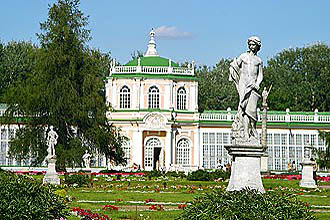|
 Kuskovo is almost unique among Russian aristocratic country houses in that it has original interiors to match its glorious facades. Once a village to the south-east of Moscow, it was razed to the ground during the Polish invasion of 1611, and was used as a hunting reserve until Count Boris Sheremetev, one of Peter the Great's leading generals, decided to build a summer home here.
Kuskovo is almost unique among Russian aristocratic country houses in that it has original interiors to match its glorious facades. Once a village to the south-east of Moscow, it was razed to the ground during the Polish invasion of 1611, and was used as a hunting reserve until Count Boris Sheremetev, one of Peter the Great's leading generals, decided to build a summer home here.
The park and palace that can be seen today were a labor of love for his son Petr, who took advantage of the nobility's new-found leisure to devote his life and his wealth to his two great passions: his home and the theatre. Serf architects and artisans were employed to create the estate, and the work was overseen by the celebrated Moscow professional Karl Blank. The ensemble comprises a palace, an adjoining church, and a formal baroque park filled with statues and follies. The result is a fascinating mixture of late baroque and early neoclassicism, with the two styles overlapping surprisingly harmoniously in their uniquely Russian interpretations.
The palace, a single-storey, salmon pink-and-white structure, is a fine and rare example of wooden neoclassicism. It was completed in 1775, and the rich interiors remain unchanged since 1779. They include a room hung exclusively with exquisite Flemish tapestries, an abundance of silk wallpaper and an impressive collection of 18th century European and Russian paintings.
Highlights of the park include the entertainingly pretty Italian, Dutch and Swiss Cottages, Blank's Hermitage and the old Orangery, which is home to the State Ceramics Museum, an extensive and absorbing collection of porcelain from the 18th century to the present day.
Petr Sheremetev's son Nikolai shared his father's love for the theater, but preferred to build his own estate at Ostankino. Further troubles beset Kuskovo after the emancipation of the serfs in 1861, which left the Sheremetevs financially incapable of maintaining the large formal parks. The garden at Kuskovo became overgrown, surrounding lands had to be sold, and the last Count Sheremetev was reduced to building a small wooden dacha next to the palace so that he could continue to live on the family estate. In 1919, the Bolshevik government nationalized the estate, and it has since been one of the favorite attractions for Muscovites in the summer months.
Getting there: from Ryazansky Prospect take bus 133 or marshrutka 208 to the Kuskovo stop.
Opening hours: From 16 October to 14 April - daily from 10:00 to 16:00. From 15 April to 15 October - daily from 10:00 to 18:00. Closed Mondays, Tuesdays and the last Wednesday of each month. Also closed during heavy rain.
|

 Kuskovo is almost unique among Russian aristocratic country houses in that it has original interiors to match its glorious facades. Once a village to the south-east of Moscow, it was razed to the ground during the Polish invasion of 1611, and was used as a hunting reserve until Count Boris Sheremetev, one of Peter the Great's leading generals, decided to build a summer home here.
Kuskovo is almost unique among Russian aristocratic country houses in that it has original interiors to match its glorious facades. Once a village to the south-east of Moscow, it was razed to the ground during the Polish invasion of 1611, and was used as a hunting reserve until Count Boris Sheremetev, one of Peter the Great's leading generals, decided to build a summer home here.